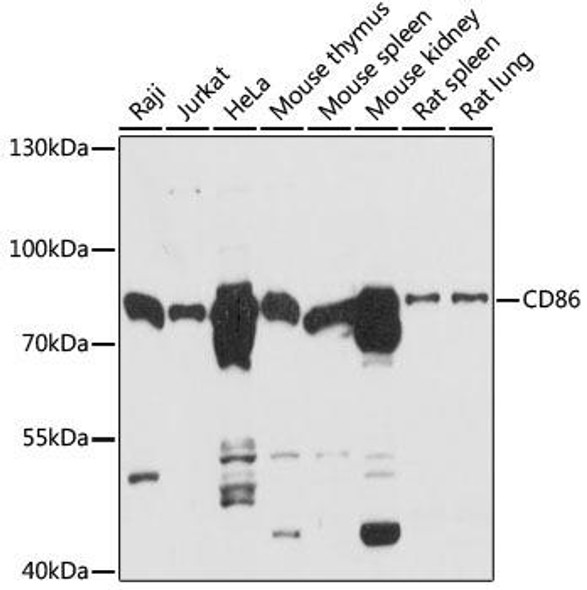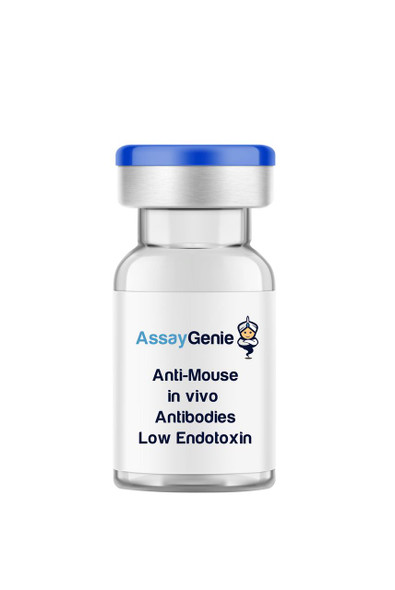Immunology Antibodies 3
Anti-CD86 Antibody (CAB19026)
- SKU:
- CAB19026
- Product Type:
- Antibody
- Reactivity:
- Human
- Reactivity:
- Mouse
- Reactivity:
- Rat
- Host Species:
- Rabbit
- Isotype:
- IgG
- Research Area:
- Immunology
Description
| Antibody Name: | Anti-CD86 Antibody |
| Antibody SKU: | CAB19026 |
| Antibody Size: | 20uL, 50uL, 100uL |
| Application: | WB |
| Reactivity: | Human, Mouse, Rat |
| Host Species: | Rabbit |
| Immunogen: | A synthesized peptide derived from human CD86 |
| Application: | WB |
| Recommended Dilution: | WB 1:500 - 1:2000 |
| Reactivity: | Human, Mouse, Rat |
| Positive Samples: | Raji, Jurkat, U-251MG, Mouse spleen, Mouse liver, Rat thymus |
| Immunogen: | A synthesized peptide derived from human CD86 |
| Purification Method: | Affinity purification |
| Storage Buffer: | Store at -20°C. Avoid freeze / thaw cycles. Buffer: PBS with 0.02% sodium azide, 0.05% BSA, 50% glycerol, pH7.3. |
| Isotype: | IgG |
| Sequence: | Email for sequence |
| Gene ID: | 942 |
| Uniprot: | P42081 |
| Cellular Location: | |
| Calculated MW: | 70kDa |
| Observed MW: | 80kDa |
| Synonyms: | B7-2, B7.2, B70, CD28LG2, LAB72, CD86 |
| Background: | This gene encodes a type I membrane protein that is a member of the immunoglobulin superfamily. This protein is expressed by antigen-presenting cells, and it is the ligand for two proteins at the cell surface of T cells, CD28 antigen and cytotoxic T-lymphocyte-associated protein 4. Binding of this protein with CD28 antigen is a costimulatory signal for activation of the T-cell. Binding of this protein with cytotoxic T-lymphocyte-associated protein 4 negatively regulates T-cell activation and diminishes the immune response. Alternative splicing results in several transcript variants encoding different isoforms.[provided by RefSeq, May 2011] |
| UniProt Protein Function: | CD86: Receptor involved in the costimulatory signal essential for T-lymphocyte proliferation and interleukin-2 production, by binding CD28 or CTLA-4. May play a critical role in the early events of T-cell activation and costimulation of naive T-cells, such as deciding between immunity and anergy that is made by T- cells within 24 hours after activation. Isoform 2 interferes with the formation of CD86 clusters, and thus acts as a negative regulator of T-cell activation. 4 isoforms of the human protein are produced by alternative splicing. |
| UniProt Protein Details: | Protein type:Immunoglobulin superfamily; Membrane protein, integral Chromosomal Location of Human Ortholog: 3q21 Cellular Component: cell surface; intracellular membrane-bound organelle; plasma membrane; integral to membrane; external side of plasma membrane Molecular Function:protein binding; coreceptor activity; receptor activity; receptor binding Biological Process: positive regulation of lymphotoxin A biosynthetic process; negative regulation of T cell anergy; T cell activation; viral reproduction; nerve growth factor receptor signaling pathway; positive regulation of transcription, DNA-dependent; positive regulation of interleukin-2 biosynthetic process; myeloid dendritic cell differentiation; positive regulation of activated T cell proliferation; positive regulation of interleukin-4 biosynthetic process; positive regulation of T-helper 2 cell differentiation; cell-cell signaling; T cell proliferation during immune response; positive regulation of cell proliferation; response to yeast; defense response to virus; aging; response to drug; epidermal growth factor receptor signaling pathway; fibroblast growth factor receptor signaling pathway; phosphoinositide-mediated signaling; B cell activation; T cell costimulation; toll-like receptor signaling pathway; innate immune response; immune response |
| NCBI Summary: | This gene encodes a type I membrane protein that is a member of the immunoglobulin superfamily. This protein is expressed by antigen-presenting cells, and it is the ligand for two proteins at the cell surface of T cells, CD28 antigen and cytotoxic T-lymphocyte-associated protein 4. Binding of this protein with CD28 antigen is a costimulatory signal for activation of the T-cell. Binding of this protein with cytotoxic T-lymphocyte-associated protein 4 negatively regulates T-cell activation and diminishes the immune response. Alternative splicing results in several transcript variants encoding different isoforms.[provided by RefSeq, May 2011] |
| UniProt Code: | P42081 |
| NCBI GenInfo Identifier: | 317373339 |
| NCBI Gene ID: | 942 |
| NCBI Accession: | P42081.2 |
| UniProt Secondary Accession: | P42081,Q13655, Q6FHB1, Q6GTS4, Q7M4L5, A0N0P0, B7Z2F3 B7Z702, E7ETN5, E9PC27, |
| UniProt Related Accession: | P42081 |
| Molecular Weight: | 329 |
| NCBI Full Name: | T-lymphocyte activation antigen CD86 |
| NCBI Synonym Full Names: | CD86 molecule |
| NCBI Official Symbol: | CD86 |
| NCBI Official Synonym Symbols: | B70; B7-2; B7.2; LAB72; CD28LG2 |
| NCBI Protein Information: | T-lymphocyte activation antigen CD86; BU63; FUN-1; CTLA-4 counter-receptor B7.2; B-lymphocyte activation antigen B7-2; CD86 antigen (CD28 antigen ligand 2, B7-2 antigen) |
| UniProt Protein Name: | T-lymphocyte activation antigen CD86 |
| UniProt Synonym Protein Names: | Activation B7-2 antigen; B70; BU63; CTLA-4 counter-receptor B7.2; FUN-1; CD_antigen: CD86 |
| UniProt Gene Name: | CD86 |
| UniProt Entry Name: | CD86_HUMAN |







